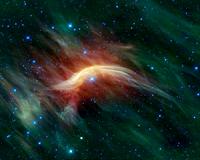 |
Moscow, Russia (RIA Novosti) Feb 01, 2011 Scientists claim that Betelgeuse, a star 640 light years away from Earth, is going to explode soon. Nikolai Chugai, head of the department of Variable Stars and Astronomical Spectroscopy of the Russian Academy of Sciences' Institute of Astronomy shares his views with RIA Novosti's Samir Shakhbaz, on possible threats and impact this star may cause to our planet. Samir Shakhbaz: Good afternoon, Mr. Chugai. An Australian scientist claims that the star Betelgeuse is going to explode. Betelgeuse is 640 light years away from the Earth, which is very close for objects in space. The explosion will be extremely powerful and we'll be able to observe the supernova from the Earth. What have you heard about this news? Is it of legitimate interest to the scientific community? Nikolai Chugai: Right now we cannot say for sure when it will explode. But yes, Betelgeuse is commanding the attention of astrophysicists for a number of reasons. First of all, it is one of the brightest red super giants.
S.S.: How much bigger is it than the Sun? For the bulk of its life, it was a blue super giant, like Rigel (Beta Orionis). It existed for ten million years as a blue supergiant, and became a red supergiant only in the last 100 thousand years. Betelgeuse is actually the brightest star in the constellation Orion in the winter sky.
S.S.: Can we see them from Earth with the naked eye? In 1604, Kepler witnessed another supernova, the last one that was visible in our galaxy. However, we know that another supernova in the constellation Cassiopeia appeared 100 years after the one Kepler saw, but for some reason it wasn't visible in Europe. It probably occurred in the fall or winter when the sky was overcast. As for Betelgeuse, astrophysicists would love to witness it explode and become a supernova, but that could happen at any time in the course of its 100 thousand years as a red super giant. And we don't know if we are in the beginning, middle, or end if this period.
S.S.: And could the star have already exploded but the light rays from it haven't yet reached us?
S.S.: In other words, it may have already exploded but we just can't see the effects. There are predictions of an apocalypse in 2012. Could the energy and particles emitted from the supernova put the Earth in danger? Should we be scared? We also know what its maximum luminosity will be; we have seen similar ones in other galaxies. It will be bright enough to light up the night sky as much as the Moon does. As for gamma rays or high-energy particles, there's no reason to worry about them. We have nothing to be concerned about before the shock wave reaches the Earth, and this won't happen for a very long time. It will expand at a speed well below the speed of light. If it takes the speed of light 640 year to reach the Earth, something travelling a hundred times slower will take a very long time to reach us.
S.S.: As I understand, there are lots of potential research topics to choose from in your field. Why do you focus on supernovas? There are many reasons to find supernovas interesting. For example, supernovas play a decisive role in the formation of elements in the universe. When the universe was born as a result of a Big Bang, it was initially composed of just two elements, hydrogen and helium. These elements alone could not produce planets, solid bodies or life. But when subjected to the thermonuclear processes inside stars, they combine to make new elements. When stars die, they explode, ejecting these new elements, created as a result of a thermonuclear fusion, into space. So, in a very real sense, we owe our very existence to supernovas.
Source: RIA Novosti
Share This Article With Planet Earth
Related Links Russian Academy of Sciences' Institute of Astronomy Stellar Chemistry, The Universe And All Within It
 Runaway Star Plows Through Space
Runaway Star Plows Through SpacePasadena CA (JPL) Jan 27, 2011 A massive star flung away from its former companion is plowing through space dust. The result is a brilliant bow shock, seen here as a yellow arc in a new image from NASA's Wide-field Infrared Survey Explorer, or WISE. The star, named Zeta Ophiuchi, is huge, with a mass of about 20 times that of our sun. In this image, in which infrared light has been translated into visible colors we see ... read more |
|
| The content herein, unless otherwise known to be public domain, are Copyright 1995-2010 - SpaceDaily. AFP and UPI Wire Stories are copyright Agence France-Presse and United Press International. ESA Portal Reports are copyright European Space Agency. All NASA sourced material is public domain. Additional copyrights may apply in whole or part to other bona fide parties. Advertising does not imply endorsement,agreement or approval of any opinions, statements or information provided by SpaceDaily on any Web page published or hosted by SpaceDaily. Privacy Statement |